Kombucha’s popularity continues to rise and with it curiosity about how to decipher Kombucha nutritional panels and labels to understand what type of Kombucha and how “healthy” it may be.
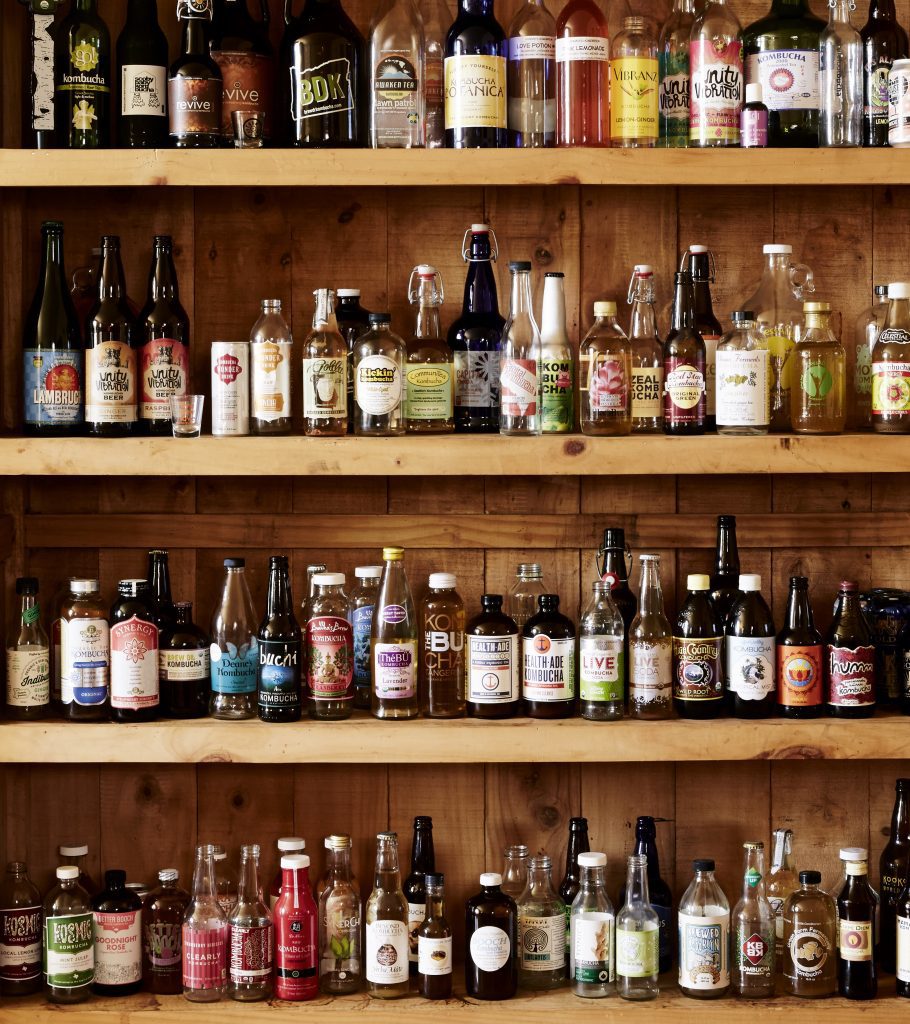
copyright Matt Amendariz for The Big Book of Kombucha, Storey 2016
Styles of Commercial Kombucha
Back in July of 2020, Kombucha Brewers International (KBI) launched the first Kombucha Industry Code of Practice which details the definition of Kombucha including methods of production, labeling terms and process steps. It was launched as a Code of Practice to allow it to continue to evolve as the industry is young and continues to need more research to better understand the authenticity (what does that mean and how does one achieve it?) of any particular brand. Since authentic can be a loaded term, KBI has instead used the terminology “Traditionally Fermented Kombucha Tea” which reflects what the vast majority of homebrewers are producing and “Kombucha” which encompasses many other iterations from different substrates (yerba mate, coffee, herbs, etc.) and processes (sterile filtration, dealcoholization, pasteurization, from concentrate, etc.)
Commercial Kombucha is a 21st century industry and strives to be a leader in labeling transparency. The processed foods and industrialization of the food supply in the 20th century through the use of pesticides, GMOs, toxic chemicals and preservatives, mislabeling, and lack of nutrients has left the world depleted and sick. The Kombucha industry strives to create products that are minimally processed and provide nutrition in a living form. Letting consumers know “what’s on the label is what’s in the bottle” is key to creating confidence in our products and to empower consumers to make an informed decision about which type of products best serves their individual needs for each use occasion.
Front of Label Requirements
- From Concentrate – created using “high density starter” or “kombucha vinegar”
- Non-alcoholic
- Diluted with water
- Backsweetened with non-fermentable sugar (stevia, monkfruit, etc)
- Shelf stable
- Does not require refrigeration
- Pasteurized – heat treated to kill organisms
- Shelf stable
- Does not require refrigeration
- Prevents alcohol level from changing
- Sterile Filtered – passed through a 0.45 micron filter which removes all living organisms
- Shelf stable
- Does not require refrigeration
- Prevents alcohol level from changing
Ingredient Panel Label Requirements
- Dealcoholized
- Cone separator that removes alcohol
- CO2 added
- Many people report not being able to tolerate forced carbonation in sodas and other beverages
- Added probiotics
- Lab grown and patented probiotics are to be listed on the label
- They are identified by the letters and numbers combination following the name of the strain of organism
- Filtered
- If passed through a filter of 50 microns
- Filtering removes yeast particles which creates a clearer product and can help control ethanol production
- It also removes flavor components and nutrients
- Refrigeration requirement
- Only needed for raw, unpasteurized products
- Refrigeration is key to controlling ethanol production
- Cold supply chain distribution and storage can be challenging and costly which is why some brands choose to use other methods to create shelf stability
- Alcohol statement
- Ethanol is one of Kombucha’s natural preservatives and provides a medicinal benefit
- Ethanol in traditionally fermented Kombucha tea is non-intoxicating
- Consumers are provided this information to help them decide if consuming this type of Kombucha is right for their body
The vast majority of Kombucha products in the market, especially those by small producers, will be closer to the type of Kombucha most people are making at home, though they are often filtered and/or force carbonated to prevent overfoaming, bottle explosions and to control ethanol compliance. Here in the US, KBI is advocating to raise the taxation threshold of Kombucha from 0.5% ABV to 1.25% ABV so that consumers continue to have access to products that require less processing.
SIGN THE PETITION TO ASK YOUR REPRESENTATIVE TO SUPPORT THE KOMBUCHA ACT.
Added Sugars
According to rule changes by the FDA, any product that uses sugar must include that on the label as “Added Sugars”. The challenging aspect of this rule for Kombucha and other fermented beverages is that the sugar content remaining post fermentation has to be reported as “Added Sugars” even if no additional sugar is added to the product. Read more about it here.
The other vital piece of information missing from the label that creates confusion when comparing Kombucha to other beverages is that everything is lumped together as “sugars.” However, the sugar in Kombucha is already fermented meaning that sucrose, a disaccharide, has already been broken down into its monosaccharide components – fructose & glucose – both of which have a lower glycemic impact on the body. When comparing sugar grams with soda or energy drink labels, this is not an “apples to apples” comparison. Even if the Kombucha seems to have a higher sugar content, the impact on the body is very different. Its the “teaspoon of sugar that helps the medicine go down” and allows the consumer to enjoy the natural organic acids of Kombucha that support a healthy liver and metabolism.
Label Dissection
We’ll take a look at some of the popular brands of Kombucha and see how they are presenting their information.
“Traditionally Fermented Kombucha Tea”
GT’s Classic Raw Kombucha (independently owned)
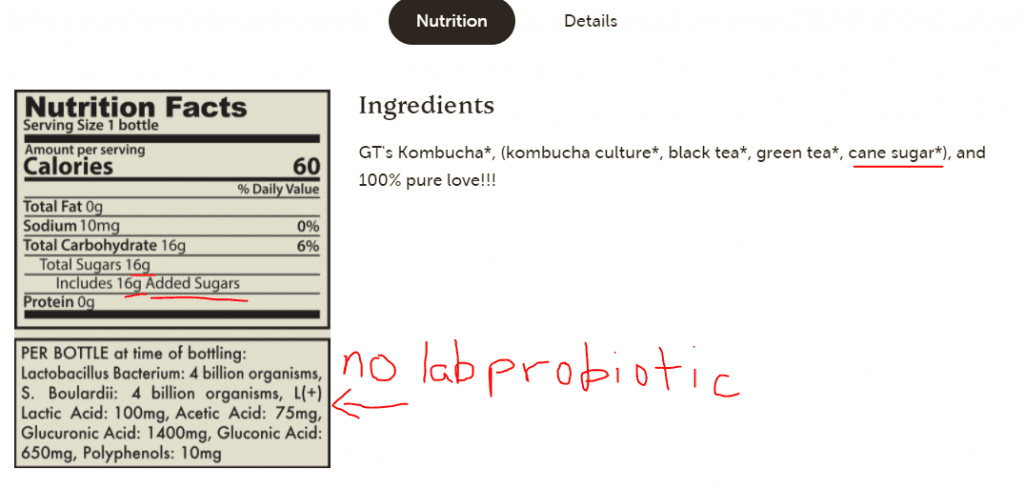
“Traditionally Fermented Kombucha Tea” – has tea, sugar, SCOBY and no lab generated probiotic added. All sugars are listed as “added sugars” but notice how they are not broken out into “fructose & glucose” so the consumer may not realize that the sugar in Kombucha isn’t the same as in other beverages.
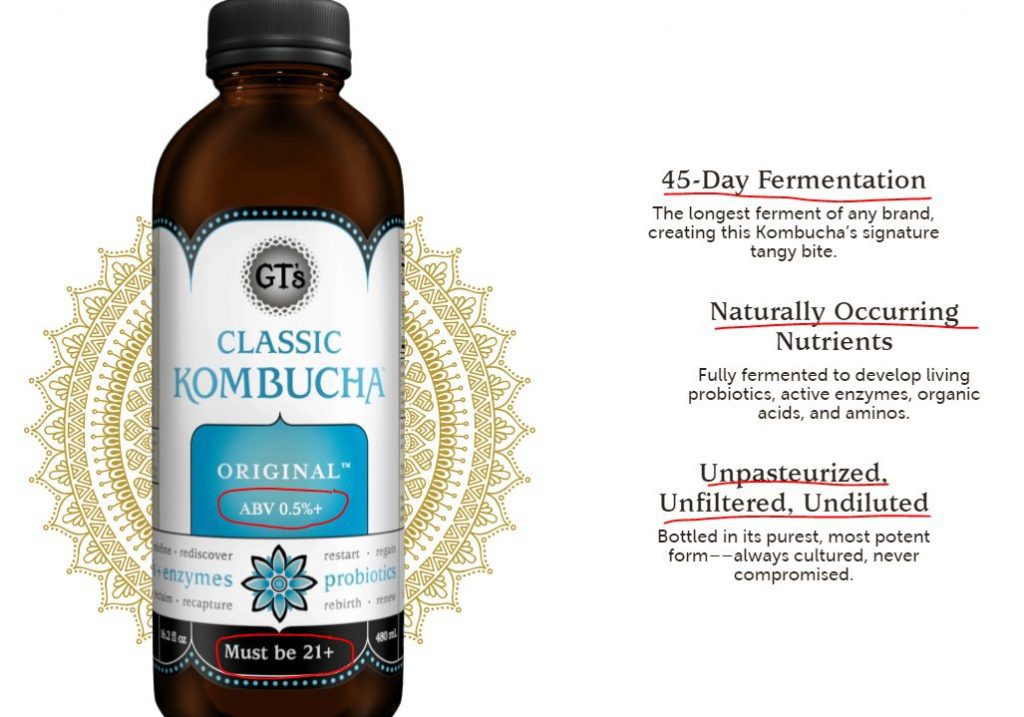
All “Traditionally Fermented Kombucha Tea” contains alcohol – its a preservative and increases absorption of nutrients – however it is still “non-intoxicating” but is currently taxed like beer and can’t be sold everywhere, thus limiting access to traditionally fermented beverages – sign the petition to ensure these products are available everywhere to everyone. Alcohol warning will continue to be listed on the bottle for anyone who needs to avoid consuming alcohol.
Revive Kombucha bottle (ownership stake by Peet’s Coffee)
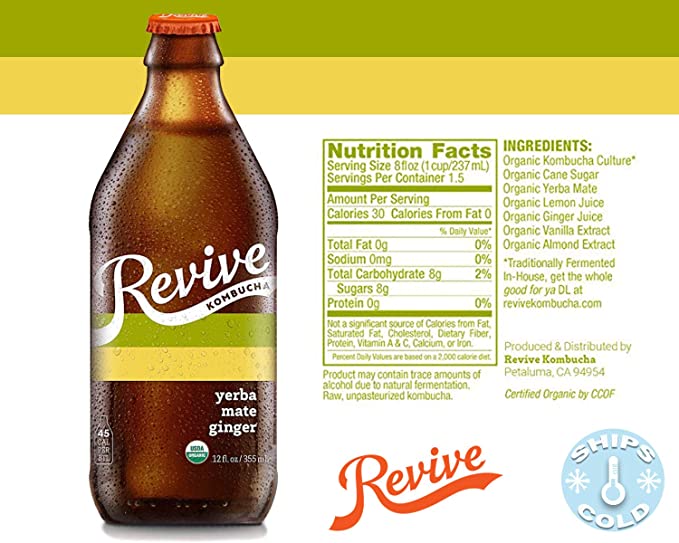
Revive’s BOTTLED product is NOT pasteurized and is made with sugar without an added probiotic which means it would qualify at “Traditionally Fermented Kombucha Tea” – note alcohol statement under nutrition panel.
GT’s Synergy Kombucha
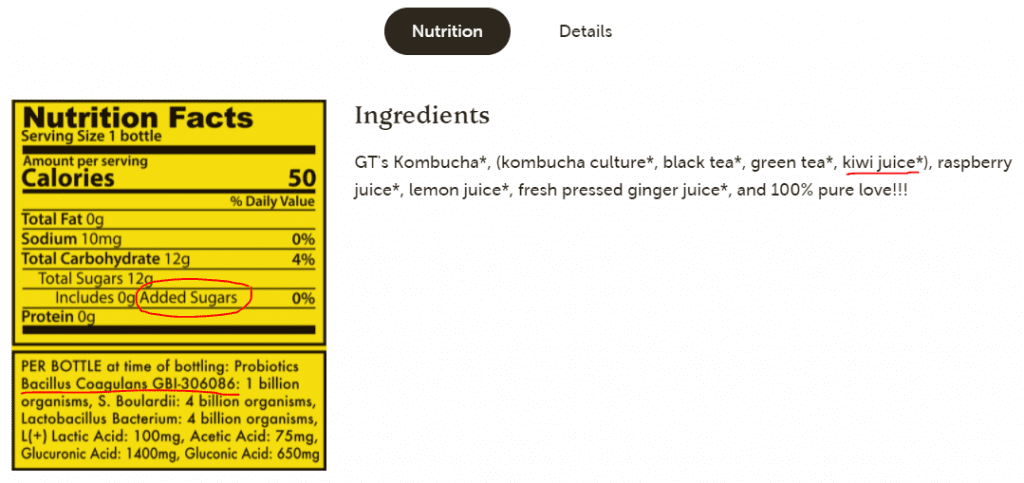
Notice ingredients list – no sugar is used in the primary fermentation of Synergy – rather it is kiwi juice. Therefore, no “added sugars” are needed since sucrose or cane sugar isn’t used in primary. Also notice the lab created probiotic – any strain that has a number after it is patented.
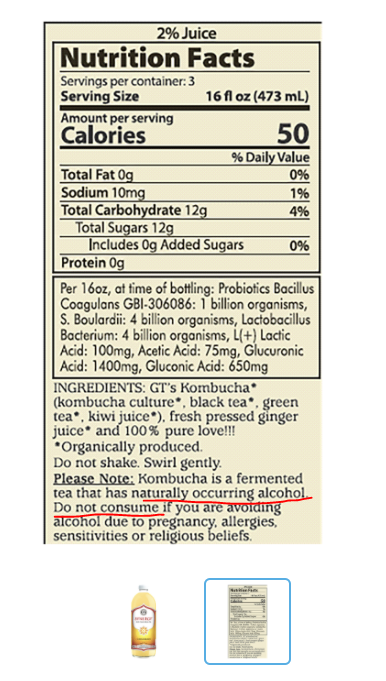
Alcohol statement on GT’s Gingerade Kombucha
Pasteurized Kombucha
Revive Kombucha (cans)
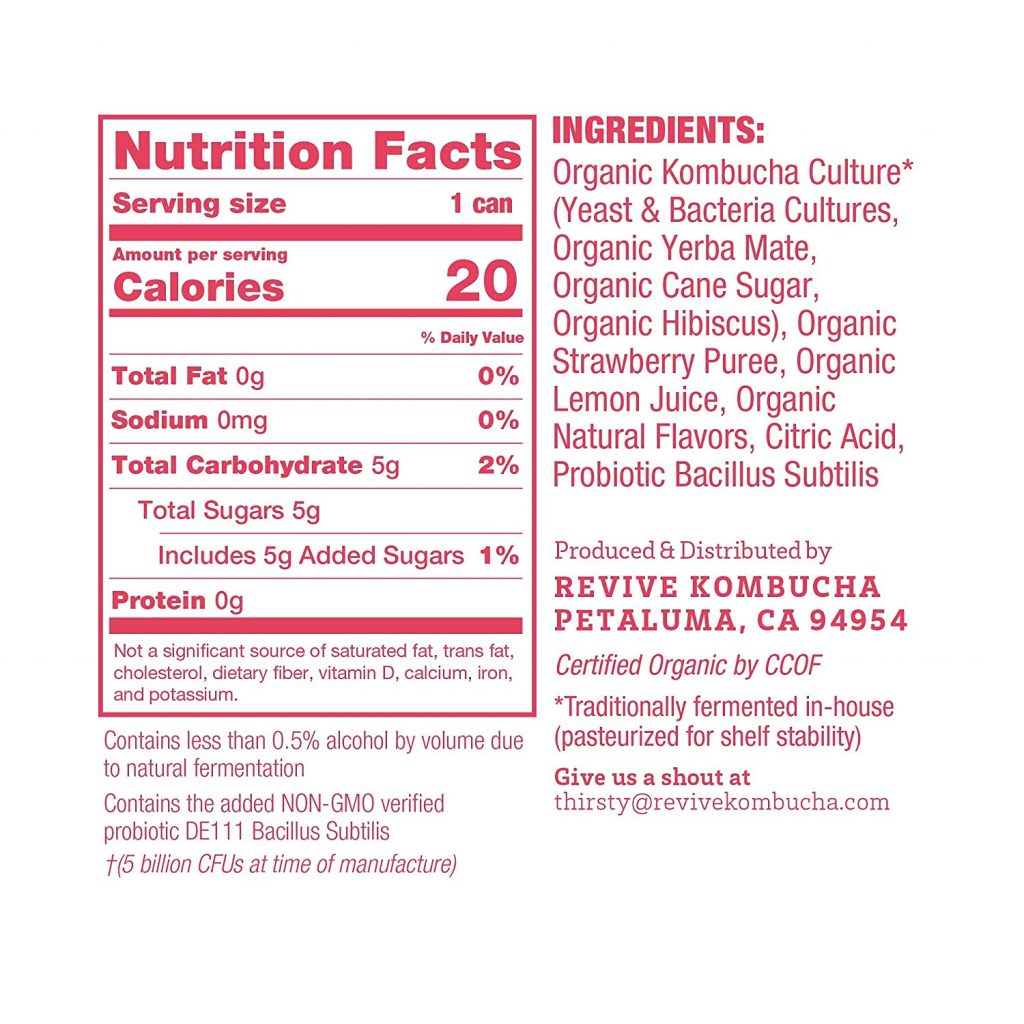
This is Revive’s CANNED product label image. Even though the label says “Traditionally Fermented” due to the addition of non-native probiotics (DE111 Bacillus Subtilis) and pasteurization, this would be in the “Kombucha” category. We are glad to see they have indicated the product is pasteurized, though to be in compliance with the Code, that would need to be stated on the front of the label.
Kombucha from Concentrate
KeVita Kombucha (owned by Pepsi Cola)
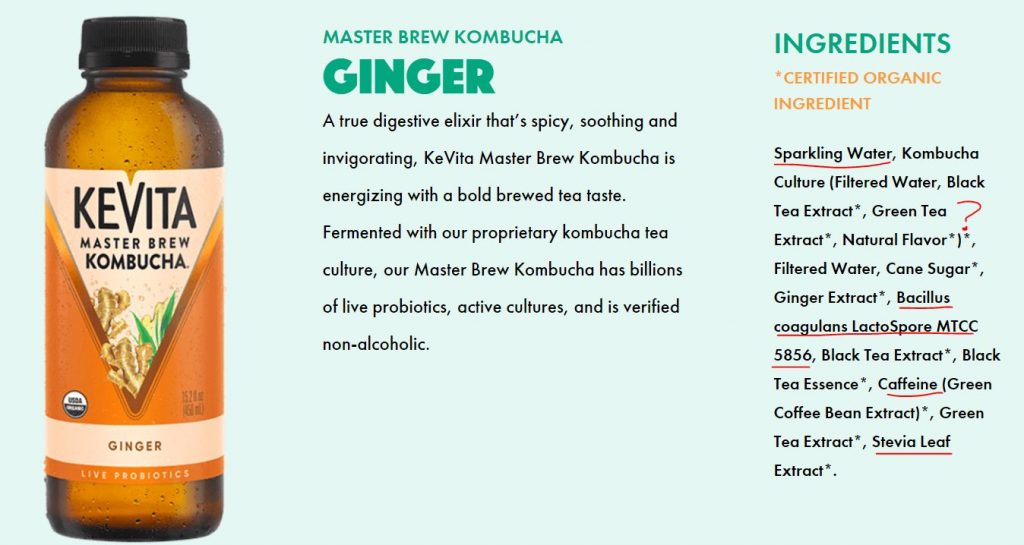
Notice the first ingredient is sparkling water. No indication of any type of living Kombucha culture is listed in the ingredients. Lab created probiotic and added caffeine, plus stevia indicates this is a “from concentrate” product with flavorings added. However, they are not listing on the label that it is “from concentrate.” Nor is “pasteurized” listed even though KeVita lost a class action lawsuit that requires their products indicate “pasteurized” on the label. Still better than an energy drink or a soda, but not exactly a “traditionally fermented Kombucha tea.”
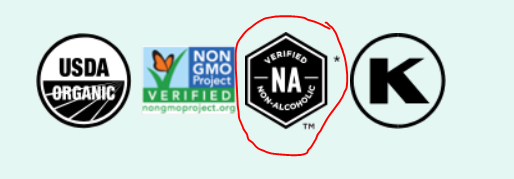
The “Verified Non-Alcoholic” is a symbol made up by Pepsi that indicates in lab tests, they’ve verified the product does not contain any alcohol. There is no “Verified Non-Alcoholic” organization that independently audits or validates this seal. Check to see which other brands also use this seal.
Humm Kombucha
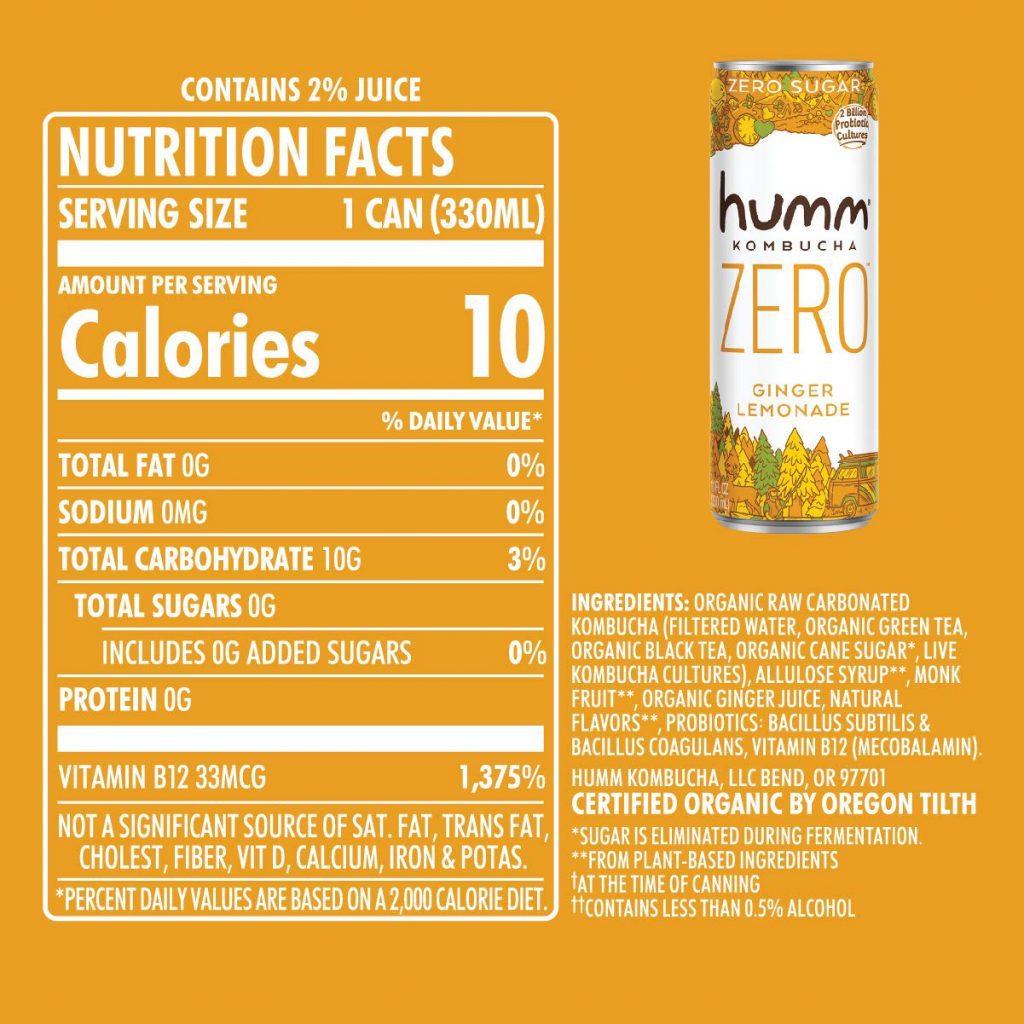
“Sugar is eliminated during fermentation” is one of the code ways of saying “from concentrate”. Basically the brew is fermented so no sugar remains and then is back sweetened with non-fermentable sugar (stevia, monk fruit, etc) to create a “zero calorie” product. This also contains “Added Probiotics” even though the patent number isn’t listed (bacillus subtilis & bacillus coagulans). Many products on shelves these days carry these same lab created probiotics. However, they do list “Live Kombucha Cultures” as well as sugar so presumably it was fermented. The reason there is 0g added sugars is because they fermented all the sugar out. Is it also pasteurized? How is it shelf-stable? Is it just because its from concentrate? Notice there’s no “keep refrigerated” warning on the label.
Manna-K & KefiViva
These two companies manufacture Kombucha Concentrate (though they may go by other names) that are used by several brands across the globe yet are not listed on the label as such. Some will claim that these are “high density starter” however, if you go from “starter” to packaged Kombucha in 2-4 days, is it really Kombucha? For example, if you were to discover the “craft beer” you were drinking was made by combining beer concentrate with water and flavorings, would you still consider it craft?
Again, these products are better for you than a soda or energy drink, but doesn’t the Kombucha Consumer deserve transparency on the label so they can select the product that matches with their needs? By not including these ingredients on the label, are manufacturers hiding the truth from their customers? Maybe nobody cares because it tastes good. Would their perception change if all of these products were labeled correctly?
If you aren’t certain which processes are being exerted to your brew, ASK THE BREWER! Most websites have a contact form where you can send a message and ask if their product is “from concentrate”, “pastuerized” or “sterile filtered”
Sterile Filtration
Jarr Kombucha (owned by Duvel)

While not listed on Jarr Kombucha’s label, their website indicates that it is filtered which creates a “shelf stable” product. This is equivalent to “sterile filtered” in the Code and we believe consumers ought to see it as soon as they pick up the bottle. Their website goes on to state that there are no proven probiotics in Kombucha which is why its fine to filter out everything to create a shelf stable product. We have seen these “pharmaceuticalized” arguments against the probiotic benefits of traditional fermented foods because it favors those who create lab generated “probiotics”. The reality is that we still have hardly any idea what exactly the microbiome needs nor in what doses. If we all start consuming the same probiotic foods, we essentially end up in monoculture yet again. What we DO know is that diversity is key and by removing the yeast and bacteria from Kombucha, what are we sacrificing?
Dealcoholized
Brew Dr Kombucha (independently owned)
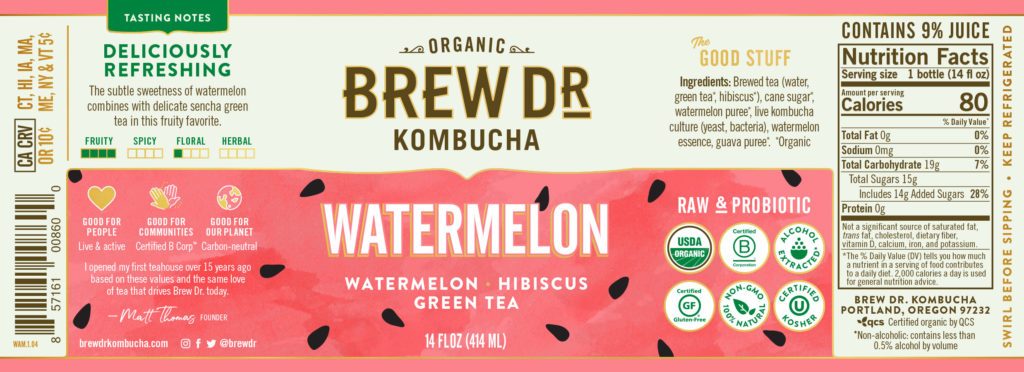
Notice the seals section says “Alcohol Extracted” – they are using technology found in the wine industry that removes all of the alcohol from the product in order to remain in compliance, but what else is removed by that process? It also has “keep refrigerated” indicating no additional pasteurization or sterile filtration has occurred. We also like that they are a Benefit Corporation meaning their suppliers and internal culture elevate a triple bottom line of people and planet, not just profit.
Conclusion
If you made it this far, you might be wondering, “what does this mean?” It simply means that as Kombucha has continued to grow in popularity, it has become subject to processing steps for a variety of reasons. Some brands seek funding in order to grow which means their new owners or stakeholders may have a more conventional approach to manufacturing. Once funding has been accepted, it can be difficult to say no or to stick to traditional fermentation methods because frankly, its difficult! Creating craft fermented foods and drinks are complex and not easy to control. That’s why they are CRAFT – because it takes a combination of artistry and science to create delicious ferments, batch after batch.
The best way to know is to get to know your Kombucha brewer. We always advise connecting with your local brand(s) first as they are often small family businesses that are more traditionally focused since they are making smaller batches that don’t travel as far as national or international brands. That said, there are larger brands that “do it the hard way” and stick to traditional processes even when it costs more due to cold supply chain. If it is really inexpensive, then dig a little deeper. Sometimes brands are competing on price, other times they are simply lower priced due to cheaper manufacturing processes or ingredients.
Here’s what you can do:
- Share this page – on social media, email to a friend, help spread the word and raise awareness
- Sign the petition – help support raw, unpasteurized Kombucha producers by asking your Senators and Representatives to support the KOMBUCHA Act and end taxation laws that prevent access to these healthy products that do not intoxicate. Our goal is 10,000 signatures – can you help us get there? Only takes 5 minutes!
- Become a label detective – Whenever we try ANY new product (or even if we haven’t looked at our “old favorites” lately), we MUST read the label. Our FDA does NOT have our back as evidenced by the numerous brands of food products that are sold in Europe WITHOUT the same level of harmful additives and chemicals as their American counterparts.
- Ask the manufacturer – If you are uncertain due to unclear wording or questionable label information, ASK! Send them a link to the KBI Code of Practice and ask if their label harmonizes with the Code. KBI is not a regulatory agency. That said, consumer pressure will cause manufacturers to change their labels.